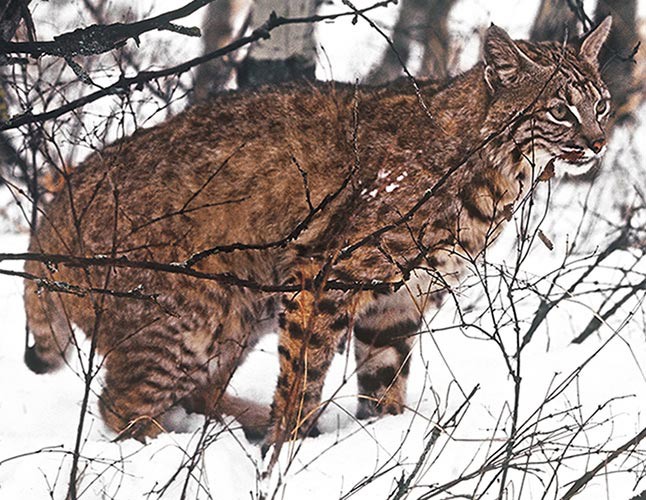It’s late February, and a tom bobcat is eagerly sauntering along – something is in the air! Lengthening daylight and warming temperatures signal the arrival of courting and breeding season.
He parallels the edge of the cliff until another trail emerges, seemingly out of nowhere. At this intersection, he pauses under a dense pine and makes what is called a “scrape,” or “scratch,” in the snow-free needle duff under the tree. Unlike ephemeral tracks, scrapes tend to last. Indeed, scrapes are the most reliable sign we can find wherever any of the world’s wild felids are in residence and communicating with one another.
The tom crouches, brings his hind feet forward behind his planted fore feet, and proceeds to push his hind feet backwards in succession. The result is a shallow, rectangular trough that culminates in a small, conspicuous pile of absorbent materials – typically conifer needles, moss, soft earth, or leaves. The piled substrate serves as both a visual and aroma-rich scent mark that lets bobcats post their social status and signal the occupancy of a given habitat, which allows them to mediate possible competition and fighting. Today, the amorous tom proclaims his reproductive potential – using the scrape as a kind of personals ad. No other animal makes exactly the same sign. The smooth-edged trough is consistently a touch wider than the side-by-side placement of the hind feet that scratched and scuffed to produce the scrape’s mound. Edge to edge, I have measured 4.5 to 5.5 inches for an average North Woods bobcat scrape, and twice that large, 8.5 to 10 inches, for a cougar’s. In snow, soft earth, or sand, the planted front-feet tracks can often be seen.
Dogs and their wild canid cousins are much admired for their sense of smell. But make no mistake – bobcats and all other species of cats are all about olfaction, too. Urine or feces are sometimes deposited on the scrape, and pedal scent derived from sebaceous glands on the bobcat’s feet is incorporated into it. Our tom bobcat will continue to wander and scent-mark throughout his neighboring females’ core areas. Making scrapes is a step away from making kittens; he’s not just pussyfooting around.




